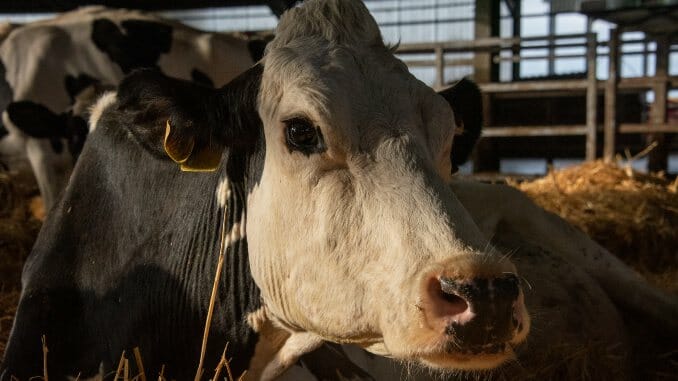The Passive Passion of Cow

Andrea Arnold’s first film in six years is a distinct departure for the English filmmaker, the spare yet thoroughly unsettling Cow. Following her 2016 road trip movie American Honey, the director’s foray into documentary is steeped in a violent monotony that both disarms and disquiets. It is completely void of dialogue, capturing the daily routine of a dairy cow and her calf through devastating vérité. There is no text or voiceover narration to sway viewer sympathies, opting instead to convey the desolate reality of livestock’s existence through candid, impartial observation. Successfully communicating the tedious torture of having one’s body mined for its resources, the film is totally immersive—even if its “how the sausage gets made” approach isn’t necessarily revelatory. However, Arnold’s aesthetic eye (and ear) suffuses Cow with a clear message, condemning the exploitation of animals in order to satiate human cravings.
Cow might closely follow two specific bovines—a milking cow named Luma and the calf she births on-screen—but it is less so a portrait of these animals than it is a detailed account of the cyclical process of dairy farming. The two “ladies,” as they’re often called by peripheral farm hands, exemplify two poles of a dairy cow’s lifespan: The two-year period before a cow is able to breed, followed by a continual existence of pregnancy, birth and lactation until death. Though the film never highlights this fact, it’s vital to understand that a dairy cow’s life expectancy spans from two to six years within one of these operations, but they can healthily live up to 20 years if they’re not subjected to this constant milking process.
It’s profoundly clear why Arnold was drawn to the striking Luma above all other potential subjects, as she sports a lovely Rorschach-esque splotch on her broad nose that recalls the image of a butterfly. This symbol perfectly encapsulates both the brevity of a dairy cow’s life and the gradual (if painful) evolution it undergoes. Cow splits its time between observing Luma and following her calf as it grows—after spending the first night after birth together, Luma and her baby are permanently separated. The calf is tagged, debudded with a cauterizing iron, and fed milk from artificial teats. Luma is milked, bred and impregnated once again. Particularly with considering the repetitive drone of Luma’s existence, there are certain parallels to Chantal Akerman’s Jeanne Dielman, documenting the minute, compounding traumas of (albeit non-human) female existence.
While Cow doesn’t overtly platform the director’s personal stance through the film’s narrative, Arnold is able to make pointed statements through music cues. “Tyrant” by Kali Uchis cheekily plays as Luma is locked in a pen and mounted by a bull; Angel Olsen’s “Unfucktheworld” seeps from a dairy farmer’s personal speaker as the cattle are herded indoors for the night; Garbage’s broodily apt grunge tune “Milk” crescendos over the film’s final scene: Luma’s daughter sprinting through green pastures with her sisters-in-strife, the viewer sick with dread knowing full well her mother’s fate soon awaits her. Arnold is well-versed in the art of utilizing a needle drop to deliver a gut punch, a talent she puts on full display (and heavily relies on) with Cow. In a film without dialogue, elaborate shot set-ups or greater narrative context, these musical moments are often the only time we are given an inkling of insight into the director’s own sentiments regarding what’s being depicted on-screen. Largely only featuring women-identifying singers (with oft-melancholy lyrics), these songs lament a sadness and exploitation intrinsic to womanhood. The same vein of violation perpetuated against these animals, trapped in a brutal web of (re)production, literally milked dry and discarded when they no longer serve the needs of humans.
-

-

-

-

-

-

-

-

-

-

-

-

-

-

-

-

-

-

-

-

-

-

-

-

-

-

-

-

-

-

-

-

-

-

-

-

-

-

-

-








































